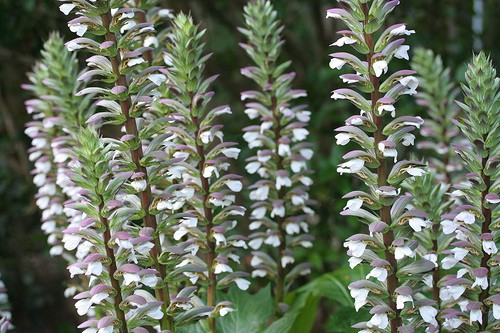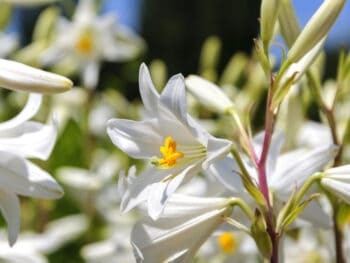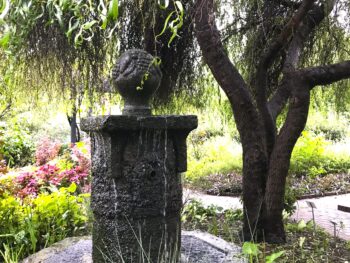With the great benefit of garden travel via GWA: The Association of Garden Communicators and the organization’s annual meetings, I have seen gardens north, south, east, and west—from Pasadena’s chaparral to Quebec’s well-watered scenery. What is one plant that surprisingly accommodates such a variety of situation? Acanthus. I have seen acanthus everywhere!
In honor of this revelation, acanthus has been added to the Plant Guide this week.
Acanthus in North America
Acanthus mollis, what North American gardeners refer to commonly as acanthus or bear’s breeches, thrives in full sun where cool summer weather abounds, and fills out equally well where hot summer temperatures suffocate as shady, woodland undergrowth. In the former, the plant will die back during winter freezes; in the latter, steamy summers send this plant underground, to reclaim its fullness in the fall. In the envious west coast conditions—not too hot, not too cold—acanthus is virtually evergreen.
Big, broad leaves make this plant appear massive, forming mounds 2 to 4 feet tall and wide. Their deep greenery is accentuated by towering, dramatic purple and white flower stalks, blooming spring to summer. Acanthus readily naturalizes and spreads by fibrous roots.
Acanthus in the Middle East
Acanthus syriacus, a closely related species, is equally prolific in the Holy Land and Middle East, propagating with weed-like fervor. Syrian acanthus has a more diminutive form, with small spines on its leaf points, and easily overtakes a field or untended ground. Thus many Biblical botanists attribute charul, Hebrew word translated “weed” or “undergrowth,” to acanthus, though the plant is not named outright in Scripture.
I went past the field of a sluggard, past the vineyard of someone who has no sense; thorns had come up everywhere, the ground was covered with weeds [acanthus], and the stone wall was in ruins.
Proverbs 24:30-31 NIV
Traditionally, you will find charul translated “nettles;” however H. B. Tristam in his Holy Land travels of the 19th century, was inclined towards acanthus species:
…the true Acanthus which overruns the corn fields as summer advances, and combines in itself the prickling powers of thistle, brier, quick-thorn, and nettle. It is perhaps the charul or Nettle of our version in Job xxx:7; PROV. xxiv. 31; Zeph. ii.9.
—H.B. Tristam, The Natural History of the Bible, 1875, page 432
Safe to say, A. syriacus is not sold commercially. Bible gardeners, plant A. mollis as a strong substitute.
Acanthus in the Architecture


Acanthus in God’s Word
Fretfully, acanthus joins the ranks of bay laurel, wormwood, and some of the fig leaves Scriptures as a warning plant, mentioned in God’s Word to highlight behavior with dire consequences. I prefer the “carrot to the stick,” so to speak; permit me to conclude with comforting acknowledgment. When seeing acanthus everywhere, be reminded—God’s Word is grounded in the land, and our Savior walked the land, confirming His willingness, desire, and promise to be with us always, everywhere.
As they talked and discussed these things with each other, Jesus himself came up and walked along with them
Luke 24:15 NIV
Let everything the Lord has made praise him everywhere in his kingdom. I will praise the Lord.
Psalm 103:21-22 NIRV
I am with you and will watch over you wherever you go, and I will bring you back to this land. I will not leave you until I have done what I have promised you.
Genesis 28:15 NIV
Photo Credits:
©2006 Snow Monkey Pottery Creative Commons
Acanthus syriacus This is how the flower looks like, so mundane until you see each small petal.
©2009 Verity Cridland Creative Commons Pillar and Acantus Moulding St Simon Stylites
©2017 Shelley S. Cramm Louis Sullivan detail, Guaranty Building, 1896, Buffalo, NY
©2017 Shelley S. Cramm Acanthus in a home garden, Buffalo, NY














